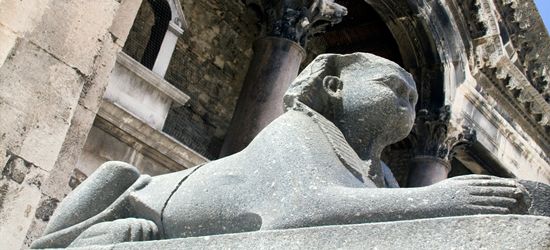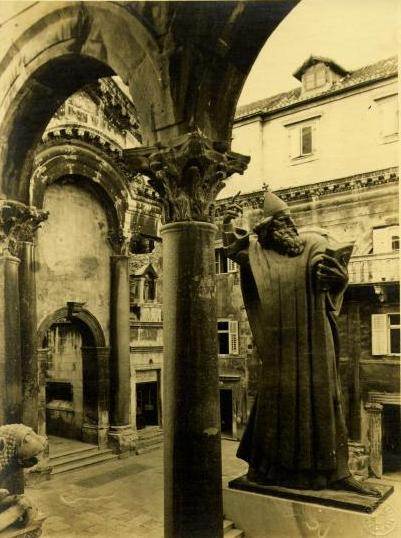Changing of the Guards in Full Swing: Actor Maro Nejašmić Banić Plays Diocletian
The Split Tourist Board and the Croatian National Theater have organized the changing of Diocletian’s guards on Peristyle during the tourist season for years.
Changing of Diocletian's Guards Returns to Peristyle on Monday
Diocletian's guards return to Peristyle!
Split in History: Red Peristyle
One of the most memorable urban interventions in Croatia took place in Split in 1968.
Sites in Split: Peristil
In Roman architecture, a peristyle is an open colonnade surrounding a court; hence the name of the central court in Diocletian’s Palace is called Peristil. It is located at the intersection of the two main streets, cardo and decumanus .The nucleus of historical sites is found here, with the prothyron, sphinxes, vestibule, various palaces, and the imposing Cathedral of St. Domnius, and Diocletian’s mausoleum as surrounding this popular square.
The 27-meter long and 13,5-meter wide imperial square is framed by two colonnades to the east and west, a prothyron to the south leading to the vestibule and further to the imperial quarters. Most of the structure is made of white stone from the nearby island of Brač however; the columns are made of Italian marble and siennite from Egypt.
Actually, Emperor Diocletian was a great lover of Egypt, which is apparent as he acquired the Peristil columns and more than a dozen granite sphinxes (from 1500 BC) from Luxor. Three sphinxes remain today; one is still located onPeristil, the second sits headless in front of the Jupiter's temple, and the third is in the city museum.

Sphinx: Image by interyachtcharter.com
The head of Peristil, the prothyron, connecting the public square to the private quarters was the only place a commoner would see the emperor as he addressed his people. The prothyron has four columns, which support a triangular gable with an arch in the center. On either side of the prothyron you will find a little chapel stemming from far after the time of Diocletian; Our Lady of the Belt (1544) and Our Lady of Conception (1650).
Behind the prothyron, you will enter a vestibule, a foyer that leads you into the emperor’s residential quarters. Known as “Vestibul,” this circular room is topped by a cupola which was once covered in mosaics and marble. Today the center of the dome is no longer there, providing clear views to the skies above. The Vestibul provides great acoustics allowing klapa bands to perform traditional a-cappella songs there in the mornings.

To the east of Peristil is the Cathedral of St. Domnius (Katedrala Sv. Duje or Sv. Dujam), where Diocletian’s mausoleum is also located; quite an oxymoron as the emperor was a known prosecutor of Christians. The cathedral consists of the octagonal mausoleum and now main part of the church and the Romanesque belfy towering above the city (see section on Cathedral of St. Domnius for further information).

Cathedral: Image by neilmeyerhoff.com
At the end of the eastern colonnade is the Renaissance-style Chapel of St. Roch (Crkvica Svetog Roka) built in 1516. Today is houses the main tourist information office.
Much later, three palaces were built along the eastern colonnade of Peristil. Closest to the prothyron is the Skočibučić-Lukaris Palace showing characteristics of a few architectural eras; Romaneque elevations to allow access through the pillars, Renaissance windows and portal, a Baroque balcony, and a Classicist third floor. This palace will be the future home of the Museum of Ecclesiastical Arts. Next up is the Cipci Palace, where the popular Luxor café is partially housed, mixing Roman, Late Gothic, Renaissance, and Baroque Styles. Inside the café, you will sit in a Roman loggia and you will notice a marble circle on the floor, stemming from the previous Temple of Venus. The last structure along the pillars is the stunning 13th century Grisogono Palace, which was later, renovated into a Gothic style. If you can pay a night in the luxury apartments here you will enjoy the magnificent UNESCO protected ceilings featuring elaborate Gothic frescoes. The Grisogono family is the oldest living family in Dalmatia.

Ceiling of Grisogono Palace: Image from tripadvisor.com
Peristil is the host to various events through the year most notably the Split Summer Festival where the square converts into an open-air opera theatre.
Fun facts: The Statue of Grgur Ninski was originally erected on Peristil but was severed into three pieces and dug underground in order to hide it from occupying forces in the Second World War. After the war it was re-erected and today is stands at the exit of the Golden Gate. Two other copies of the statue exists; in Nin and Varaždin. Later, the entire floor of Peristil was illegally painted red on January 11,1968 by an activist group demonstrating against communism in the former Yugoslavia.

Grgur Ninski on Peristil: Image from croatia.ch
Peristyle in Split Covered with Grass
Almost fifty years have passed since the artistic intervention in the late 1960s which painted the Split Peristyle in red. And now, the Peristyle will greet the citizens of Split in its green edition, reports Slobodna Dalmacija on October 26, 2015.
On the freshly installed grass lawn at the most popular square in Split, a performance titled "Breakfast on the Grass" is currently being performed. The organizers of the artistic event, Greens of Dalmatia, have decided to use the performance in order to present to the public their Green Ring project, which was created in collaboration with the "Parkovi i nasadi" city landscaping company. The project was created under the auspices of the Management Plan for the Historic Centre of Split, in order to bring about a significant horticultural improvement of the area which is under the protection of UNESCO.
The Greens claim that cities have a few degrees higher temperatures than other areas, due to the so-called heat island effect, and Split is no exception. "Stone, asphalt and concrete absorb the sun's energy and generate high temperatures. Our urban centres are not ready for this life-threatening effect. Historical cores of the cities are especially vulnerable, because they typically bring together a large number of residents and visitors."
Split is a tourist town which is inundated with numerous visitors and citizens who have absolutely no protection from temperature anomalies. "Therefore, we are forced to create green corridors and a network of parts of the city covered in shades, where we can find at least some salvation and refuge", Greens of Dalmatia explained.

